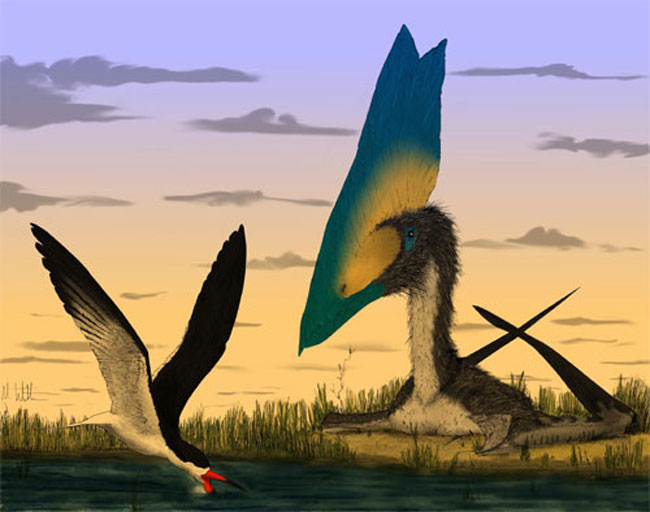Tale of Huge Reptiles Fishing While Flying Called False

Prehistoric flying reptiles known as pterosaurs are often pictured as skimming along the surface of water during flight with their mouths open, fishing on the wing.
Now scientists find this romantic Age of Dinosaurs vision unlikely. Any pterosaur trying this feeding method might have taken a nasty crash.
Pterosaurs, or "winged lizards," were the first creatures with a backbone to fly. They included the largest animals that ever flew, giants that reached more than 40 feet across in wingspan. (Despite the "saur" in their name, pterosaurs were not dinosaurs.)
How pterosaurs ate remains a mystery. Recently scientists pointed out jaw similarities between the extinct reptiles and modern birds known as skimmers (Rynchops), which graze water during flight seeking prey.
Anatomy 101
To see if this comparison might have been practical for pterosaurs, life-sized models of pterosaur jaws and modern skimmers were dragged through water flumes, with results compared with aerodynamic and hydrodynamics models by biomechanist Stuart Humphries at the University of Sheffield in England and his colleagues.
They concluded that pterosaurs weighing more than 2 pounds or so (1 kilogram) might have found skimming impossible, with their bills dragging almost like oars. Pterosaur jaws might have faced an incredible amount of drag upon dipping into the water. While the very thin bill of modern skimmers is extremely well-adapted to reduce drag, being some 2 millimeters across, the pterosaurs Humphries and his colleagues studied—which past research suggested could skim—had bills a half-inch to an inch wide (1.5 to 3 centimeters).
Get the world’s most fascinating discoveries delivered straight to your inbox.
If pterosaurs had attempted skimming, "they may well have been able to muster up enough energy to stop themselves falling out of the sky and to remove their lower jaws from the water, but anything more than a couple of seconds could result in a tumble," Humphries explained.
Indeed, this extraordinary drag could be why skim feeding is found only in three modern birds, all Rynchops.
Even smaller pterosaurs could not have skimmed, lacking the right necks and skulls for such a trick, Humphries said. Modern skimmers don't just have thin bills, but also thin skulls, large jaw muscles, reinforced joints and strong, flexible necks—anatomical traits pterosaurs would have needed to skim-feed successfully.
Questions remain
So how did the giant beasts eat?
"The most probable remaining option is that they fed by plucking food from the water surface in a similar way to gulls or albatrosses today," Humphries said. "There is evidence that some fed on hard-shelled animals, some by picking or pecking in similar ways to birds."
The findings, detailed online July 23 in the journal PLoS Biology, have not settled the issue entirely.
Paleontologist Alexander Kellner at the Federal University of Rio de Janeiro noted one pterosaur, Thalassodromeus sethi, had thin jaws, neck muscles that might have been quite strong and what might have been a horny extension at the tip of the jaw that might have affected the drag they felt in the water.
"I welcome this kind of study and, despite my criticisms, am very happy that other scientists or students have a look at fossils from a different perspective," Kellner said.
- Image Gallery: Drawing Dinosaurs
- Top 10 Beasts and Dragons: How Reality Made Myth
- Wildest Dragons of All Time: Vote for Your Favorite



